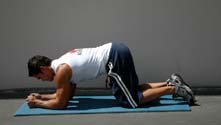Yesterday evening I watched an infomercial that guaranteed users a "ripped, sexy core." The confusions associated with core training and terminology are perhaps some of the most unfortunate misperceptions to flood the fitness world in the past decade.
Whether you are trying to improve your physique, bench press 500 pounds, excel in athletics, or simply optimize general health and wellness, there is no other musculature that I feel is more important to train and, sadly, more overlooked than the core.
I challenge anyone reading this right now to consciously flex their core. You may feel your abdominals and lower back, but do you feel your multifidis, transverse abdominis, iliocostalis, and lognissimus contracting? You can't feel them? Really?
To appreciate core training, we must first distinguish what the "core" is. Essentially, "core musculature" can be defined as the muscles that support and stabilize the lower back-pelvis-hip region during movement.
The "core" is further divided into two different muscle groups:
- Local
- Global
The latter being responsible for movement and comprised of the rectus abdominals (abs) and erector spinae (lower back).
It is the local core that I wish to discuss in this month's feature. From lifting a box or child, to walking, jogging, or jumping for a rebound, your local core is being used.
This muscle group is responsible for stabilizing the spine during activity of any intensity. In fact, research clearly suggests that strengthening these muscles may not only decrease the probability of developing lower back pain, but also help to reduce it!
It has been the observation of many fitness professionals that the majority of the population has an over-developed global core in comparison with their local.
Insufficient development of the local core is thought to create situations where forces created by global core muscles far exceed that of what the local core can control and withstand. Simply put, an individual can lift more weight than the muscles that support the spine can handle placing one at risk for injury.
The exercises involved in your core training should be specific to your goals, training history, and needs. As with any program, focus must be put on strengthening the muscles through progressively increasing the complexity and intensity of the movements.
By integrating isolated local core exercises into your free weight routine, such as the prone bridge and trunk rotations one can specifically target and strengthen their local core.
In addition, the use of upper and lower body instability devices during dynamic exercises will challenge and build core musculature used both in competition and real-world situations.
Free Weights Are Your Friends: Dispelling The Myths And Fallacies Of Free Weights
I want you to take a moment and reflect upon every physical activity you did out side of the gym this past weekend. Maybe you gardened, perhaps played with your kids, or even went canoeing and hiking; now I want you to think about what each of these activities had in common?
Not a single one involved a cable, rod, or fixed axis: They were all closed kinetic chain! There are no cables attached to your children (though I'm sure many parents wish there were at times!), no rods guiding you to lift a bag of mulch, and no levers pulling you out of bed every morning. If your daily activities do not involve a fixed range of motion, why should your resistance training?
It's a real shame the myths and fallacies surrounding free weight training have turned people away from so many advantageous exercises. The intention of this bonus material is to dispel some of these myths and discuss the many important benefits free weights have to offer over machines.
1. Free Weights Are Dangerous
Performing any exercise using incorrect form is dangerous. Driving your car can be dangerous, walking down the streets of Manhattan can be dangerous; free weight exercises are no more dangerous than those done on machines. In fact, exercising on machines is often more damaging because the movements occur through a fixed range of motion.
The use of incorrect form and limb placement misaligns the natural positioning of the body's joints, harmfully and unnecessarily stressing tendons, ligaments, and stabilization muscles. This excess stress can result in both immediate and chronic (long term) injury.
2. Machines Better "Isolate" The Muscle
The body is not an isolated unit! Let me make that clear: The body is not an isolated unit! For movement to take place around any single joint, ancillary and complimentary muscles must contract in order to provide stabilization.
Take for example bicep curls: For the biceps to raise the forearm, the deltoids and muscles of the rotator cuff must contract in order to keep the upper arm connected to the shoulder socket. The muscles of our bodies are designed and adapted to work with one another—not separately.
3. Machines Are More Effective
Machines require little use of stabilizer and local core muscles in contrast to those recruited when performing a similar movement using free weights. Take for example the isolated bicep curl machine. This exercise trains your biceps but does not force you to stabilize your torso by contracting the local and global core in the same way that performing a set of standing dumbbell curls does.
Similarly, performing an overhead press on a machine will work your deltoids and triceps but does not require full activation of the infraspinatus, supraspinatus, subscapularis, or teres minor. The leading cause of shoulder injuries can be attributed to imbalances in the strength of the deltoid compared with that of the rotator cuff muscles.
4. Free Weights Are For Bulk, Machines Are For Tone
Nothing could be further from the truth! "Tone" is a product of muscular maturity and a low body fat, nothing else. The fastest way to develop a muscle is through closed kinetic chain movements (i.e.: free weight exercises), while a good diet combined with cardiovascular training promotes reductions in body fat.
Despite the growing popularity and exotic appeal of machines, free weights should still make up the core of any resistance workout. The research time and again demonstrates that closed kinetic chain movements recruit more muscle fibers resulting in greater gains in functional strength.
This is not to say you should avoid training with machines; machines provide diversity and efficiently supplement any workout. In summary, daily activities and athletics do not involve rods or cables and neither should your training!







